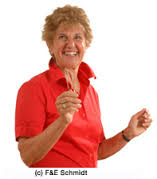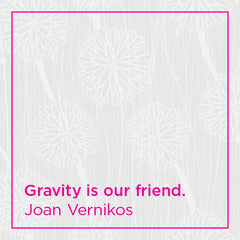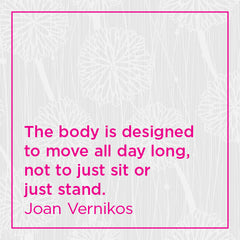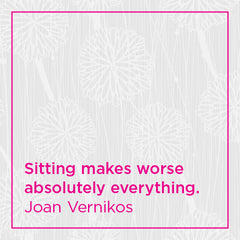Dr. Joan Vernikos with Dr. Barb
 Dr. Joan Vernikos retired in 2000 as director of Life Sciences at NASA, where she was both a researcher and an administrator. Initially recruited by NASA because of her expertise in stress, she pioneered research on how living without gravity affected the health and post-flight recovery of astronauts. She’s published several books on gravity, aging, and stress, including The G Connection: Harness Gravity and Reverse Aging, Stress Fitness for Seniors, and Sitting Kills, Moving Heals. When she isn’t writing or keeping herself in motion, Dr. Joan consults with organizations on product development and whole workplace design, and serves as chair of the Taksha University School of Integrative Medicine’s Institute for Space, Health, and Aging.
Dr. Joan Vernikos retired in 2000 as director of Life Sciences at NASA, where she was both a researcher and an administrator. Initially recruited by NASA because of her expertise in stress, she pioneered research on how living without gravity affected the health and post-flight recovery of astronauts. She’s published several books on gravity, aging, and stress, including The G Connection: Harness Gravity and Reverse Aging, Stress Fitness for Seniors, and Sitting Kills, Moving Heals. When she isn’t writing or keeping herself in motion, Dr. Joan consults with organizations on product development and whole workplace design, and serves as chair of the Taksha University School of Integrative Medicine’s Institute for Space, Health, and Aging.
Listen now.
Dr. Barb: Our guest for conversation today is Dr Joan Vernikos, who inspires me in so many ways. Joan has been a leading researcher in health, retiring from NASA as the director of Life Sciences. She has continued to work as an author, health coach, and speaker, sharing what she learned through the study of stress and gravity and how they work on our bodies. She published Sitting Kills, Moving Heals, which continues to get well-deserved attention, and Stress Fitness for Seniors as well. Welcome, Joan, thank you for joining me today.
Joan: Thank you very much for inviting me. I look forward to it.
Dr. Barb: I think that we share a passion for science, both of us having had our backgrounds primarily in science. For me it was the science of medicine. For you it was probably a bit more broad than that. One of your books is called, Harness Gravity and Reverse Aging. Certainly the idea of reversing aging is probably a topic that Americans could be consumed by, but I’m interested if you could expand to your today knowledge and help me understand more about: What role does gravity play? And what do you mean by this idea of reversing aging?
Joan: Well, the studies I did at NASA involved the question of how does gravity, or living with minimum gravity—which is 10 to the minus 5 in space, not absolute zero, people call it zero-gravity, but it isn’t—we call it micro gravity. And the studies that we did, there were of course very few astronauts who flew, so we had good data, but few data.
So we had to do something about expanding our knowledge on ground research. When we are on the ground we have gravity around us all the time, pulling in one direction, only towards the center of the earth. But, some German and Russian scientists had developed a model—simulation model—for studying the effects of reduced gravity. By lying in bed, for example, when you lie in bed, when you stand up, gravity pulls through your body in a head-to-toe direction. When you lie in bed, it pulls across your chest. So the vertical influence of gravity is diminished to a very low level. And the changes that accompanied lying in bed for example 24 hours a day, mind you—you don’t get up at all—are very similar to those we see in astronauts. Granted, maybe a little less intense.
So we used that model, I certainly introduced it from the Russians, we used that model extensively to study the effects of lying in bed for long periods of time. In fact, you don’t need to lie in bed too long, in as little as four days, well even one day, but four days you get very significant changes and my early studies were seven days and went on to thirty days. With where we could do both provocative and monitoring observation of work, on fluid metabolism, on metabolic cardiovascular changes and responses to stress, hormonal… Whatever we could do and wherever we could get collaboration from our colleagues in the broad science community, to join us to get expertise, to join us.
That’s the studies I really did. And during one of the early studies, I happened to visit a friend’s mother in a nursing home. She happened to be Greek, didn’t speak any English, ended up in a nursing home and, of course, didn’t budge from bed and she was terrified to get up. And she declined rapidly, as you can imagine. And since I was doing these studies I went in the evenings to see her. And I looked around and many of the changes were very similar to what I was seeing in my volunteers. And that got me thinking, and I thought, well, yeah, these are age-like changes, the loss of muscle, loss in bones, the orthostatic hypertension—the loss of pressure when you stand up, balance problems when you stand up again, and coordination. For starters, reduced plasma volume of 10 to 20 percent reduction in blood volume.
I was intrigued, well, yes, fine, but obviously my subjects are not getting old in bed. Because, after all when they do say, get up and move about they recover, as do astronauts when they return from short missions in the shuttle, which in those days was four to seven days. And of course, what’s happened, to cut a very long story short, astronauts now don’t recover in many areas. After six months—we have a lot of astronauts now who have been in space for six months—one in fact lost 30 percent bone in six months—bone density.
Dr. Barb: Whoa, that’s amazing.
Joan: That is amazing. But there are a couple who haven’t lost very much at all. So it is a very interesting phenomenon and I’ve been trying to encourage my colleagues to look at their genetic code—their DNA. Because obviously, there must be a predisposition somewhere. But that hasn’t been done yet as far as I know.
Dr. Barb: So, in summary, gravity really is our friend.
 Joan: Gravity is our friend. So, the conclusion I came to was, okay, in space you have minimum gravity. In lying in bed you have reduced the influence of gravity. But what about the rest of us as we get older? Well the only way I could explain it is, we use gravity less and less and less. From 20 on, when perhaps, we have peak development, to whenever we reach what I call “the risk zone,” when you start breaking bones and falling over, which, in the early days, used to be around 80, and now, unfortunately, it’s getting earlier and earlier.
Joan: Gravity is our friend. So, the conclusion I came to was, okay, in space you have minimum gravity. In lying in bed you have reduced the influence of gravity. But what about the rest of us as we get older? Well the only way I could explain it is, we use gravity less and less and less. From 20 on, when perhaps, we have peak development, to whenever we reach what I call “the risk zone,” when you start breaking bones and falling over, which, in the early days, used to be around 80, and now, unfortunately, it’s getting earlier and earlier.
So, this trajectory from age 20 to age 60, 50 or 80 or 90, when you reach the risk zone, I attribute to a great extent to reduced activity. What I call moving. It’s not exercise. We can jump to that topic in a while.
Dr. Barb: Yes, I think that’s a really, really important message you just shared. I think now, moving into that discussion, as a health care provider, as a physician for women’s health, most of my days, most of my patients, I’m trying to encourage them to improve their health and wellness, and much of my message is around exercise and trying to get them to move more. You indicate that there’s a difference between movement and exercise and I’m not sure I’ve appreciated that there’s a difference, and maybe I need to change the message I’m giving my patients. I’d be interested in having you share a little bit more about how you see the difference between movement and exercise, and how we can better inform our listeners and people like me who are interacting with individuals and trying to improve their lifestyle and therefore, wellness.
Joan: I’m delighted to have the opportunity to do it.
I discovered this as I went along, really looking back at the data and thinking it through. What became obvious to me is that the earth goes around, and as the earth goes around we have night and we have day. During the night we go lay down to sleep. And when we lie down, it’s like my bed is subject to gravity, and the effect is reduced, but it hasn’t changed, but our orientation to gravity is such that the influence of gravity is reduced. And then we have day, we have light, and we have day. And what do we do? Well what do you do when it is daylight? I’m asking you.
Dr. Barb: I start my day, and I get up, and I spend my day in motion, mostly.
Joan: Ah, you said the key word—you get up. And it is amazing how difficult it is to get audience members to come up with that simple thing. [laughs]
The first thing you do is you open your eyes, and pretty soon you stand up. And then you go to the bathroom and you make your coffee and all the other things. But from the moment you get up until you go back to bed when it’s dark again, or it’s night—you move.
 And certainly our parents and grandparents used to move all day long, as a consequence of living. Because they had to move, they bent over and reached up and made beds and cleaned and washed and gardened. And went and bought groceries and walked home or rode a bicycle, or whatever. But they moved all day long and did it until it was time again to go back to bed. Our ancestors just, they didn’t have chairs, but they squatted and they stood, and they squatted and they stood and they went searching for food, or whatever they did. Once in awhile they would chase or were chased by a wild animal. But, they would build and cook and get wood to do it and so on.
And certainly our parents and grandparents used to move all day long, as a consequence of living. Because they had to move, they bent over and reached up and made beds and cleaned and washed and gardened. And went and bought groceries and walked home or rode a bicycle, or whatever. But they moved all day long and did it until it was time again to go back to bed. Our ancestors just, they didn’t have chairs, but they squatted and they stood, and they squatted and they stood and they went searching for food, or whatever they did. Once in awhile they would chase or were chased by a wild animal. But, they would build and cook and get wood to do it and so on.
So, the body is designed to move all day long. Not to sit and not just stand. Now, the literature when I wrote my Sitting Kills book, there was no research that was cause and effect with sitting and consequences. There was research that looked at diabetic predisposition and how sitting worsened diabetic predisposition. That, in fact within thirty minutes you can get an increase in triglycerides in a non-diabetic person. Which is fascinating to me, because it takes thirty minutes to see a doctor most of the time and you're sitting in that time. Or you’ve driven an hour to get there—that’s a difference subject.
 You then, gradually between 2011 when that book came out and now, there have been a fantastical number of studies—mostly meta-analysis and I have my reservations about them, but they do serve a purpose. That absolutely—that sitting makes worse absolutely everything. Whether you’re talking about cancer—prostate, breast cancer, cardiovascular conditions, stroke, metabolic conditions, diabetes, obesity—you name it, it makes it worse.
You then, gradually between 2011 when that book came out and now, there have been a fantastical number of studies—mostly meta-analysis and I have my reservations about them, but they do serve a purpose. That absolutely—that sitting makes worse absolutely everything. Whether you’re talking about cancer—prostate, breast cancer, cardiovascular conditions, stroke, metabolic conditions, diabetes, obesity—you name it, it makes it worse.
Now, as an interesting bit of information, what has become even more interesting, because I used to talk about moving as the foundation of activity. Then you can add onto that exercise up to becoming an elite athlete where you really do all kinds of exercise-specific programs. But, you can’t exercise without the foundation. Studies have come out, clinical studies, showing that when you have people sitting for a long period of time, that most of us do these days, unfortunately. You might exercise once a day, but exercising once a day does not counteract the effect of sitting these hours of sitting, okay?
Even there is a study showing no exercise, mild exercise, slightly more than moderate exercise and vigorous exercise. And lo and behold, the mild-to-more-than-mild exercise is the best and vigorous exercise is not as good.
 Now, it still is early days, because the studies I would like to see designed and done don’t ask specifically that question. Because one of the things I then went on to postulate, coming at it from space side, is it’s a change in posture rather than just a metabolic consequence that is the key factor. And it is the neurovestibular mechanism that is involved every time you stand up. Because you only burn 12 calories every time you stand up. And okay, those can add up if you stand up often enough. And you probably need to stand up about 36 times a day from a sitting position.
Now, it still is early days, because the studies I would like to see designed and done don’t ask specifically that question. Because one of the things I then went on to postulate, coming at it from space side, is it’s a change in posture rather than just a metabolic consequence that is the key factor. And it is the neurovestibular mechanism that is involved every time you stand up. Because you only burn 12 calories every time you stand up. And okay, those can add up if you stand up often enough. And you probably need to stand up about 36 times a day from a sitting position.
The last study I did at NASA, took volunteers, they laid in bed for four days. That way I know the plasma volume is reduced, the O2 maximum is reduced, you get insulin resistance and orthostatic hypertension, you can see all that—and you increase your calcium excretion—presumably coming from both. All that happens rapidly, within four days and probably sooner. So, I had the subjects (it was a randomized test) either stand up every hour on the hour, and that time I had them stand up for 15 minutes (which is way too much, they don’t need that) or stand up and walk. I was not, frankly, looking at the walking, how the walking would prevent the changes we saw lying in bed 24 hours continuously.
And the standing up without the walking was my control, because after all, to walk you had to stand up. Well, this fancy statistician-biased statistician who worked with me, when the results were in and the randomized results were sorted out, he said to me, “You’re not going to like this.” I said, what do you mean, I’m not going to like this? He said, “The standing is better than the walking.”
Dr. Barb: Fascinating.
Joan: So I scratched my head and I thought, oh Joan, not again. How do you come up with these unusual observations? So when we published that paper it got all kinds of awards. But I still didn’t think it really got the implication of that, because we’re so used to having to move. But the movement can just be standing up. And the standing up is fundamental. And when you stop and think about it what are we? We’ve got circulation, we’ve got neuro and metabolic changes that are going on all the time, and, yes, energy management.
![The whole integrated system [of our body] needs to be looked at.](http://cdn.shopify.com/s/files/1/0879/9522/files/Artboard_16_copy_15-partone_medium.jpg?v=1503333028) So that’s what our body is made of and the water that everything sloshes around in. So you can’t look at one thing, unfortunately you just can’t. Not just bone, or just muscle atrophy or just circulation. The whole integrated system has to be looked at. And it’s amazing to me that just the mere act of standing up, for, people say, how long? You just stand up, a minute, you wave your arms around if you like, you can do whatever you want, but it’s the postural signal.
So that’s what our body is made of and the water that everything sloshes around in. So you can’t look at one thing, unfortunately you just can’t. Not just bone, or just muscle atrophy or just circulation. The whole integrated system has to be looked at. And it’s amazing to me that just the mere act of standing up, for, people say, how long? You just stand up, a minute, you wave your arms around if you like, you can do whatever you want, but it’s the postural signal.
So I started looking at it as a signal, as a tuning mechanism if you will, in a sort of wild way. That the body, when it is inactive, when it is lying down or sitting down for hours, is not stimulated. And gravity was responsible for our evolution and our health, our development and our health.
So, it makes a sort of fundamental sense that if you do not provide that stimulation, what is the consequence? Well, the consequence is lose what we seek after so many years of doing that. And now we’re seeing these consequences showing up in children with strokes and diabetes and younger people and it’s tragic.
Dr. Barb: I had so many questions that we let the interview run beyond its allotted time. Look for part two to learn more about the science of health, gravity, and movement.
 Dr. Barb DePree, M.D., has been a gynecologist and women’s health provider for almost 30 years and a menopause care specialist for the past ten.
Dr. Barb DePree, M.D., has been a gynecologist and women’s health provider for almost 30 years and a menopause care specialist for the past ten.


0 comments